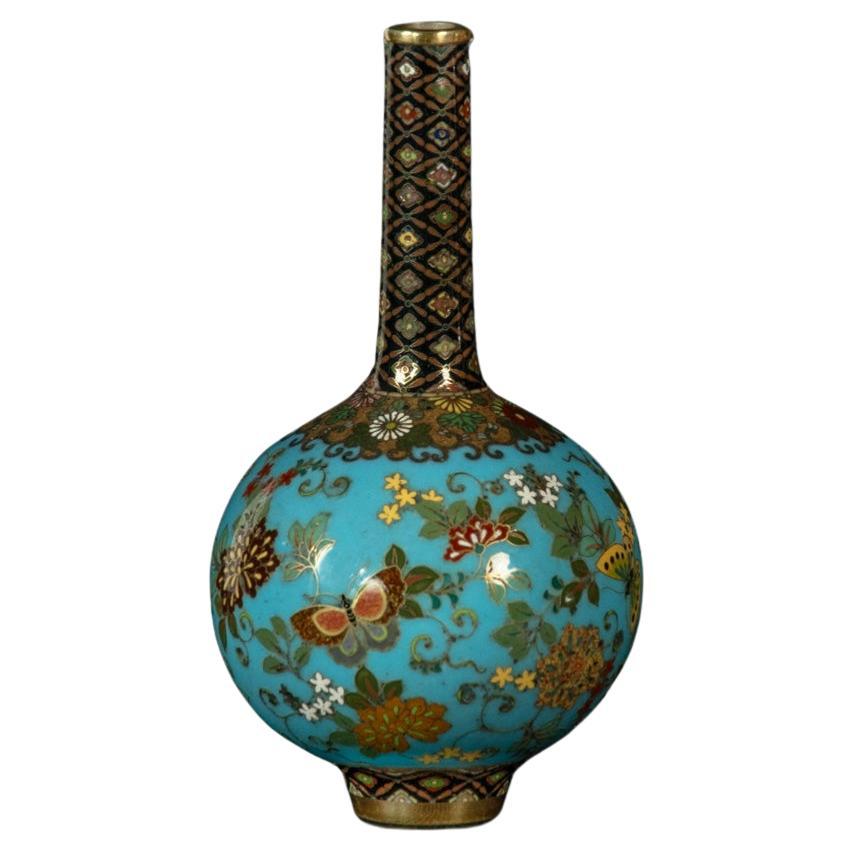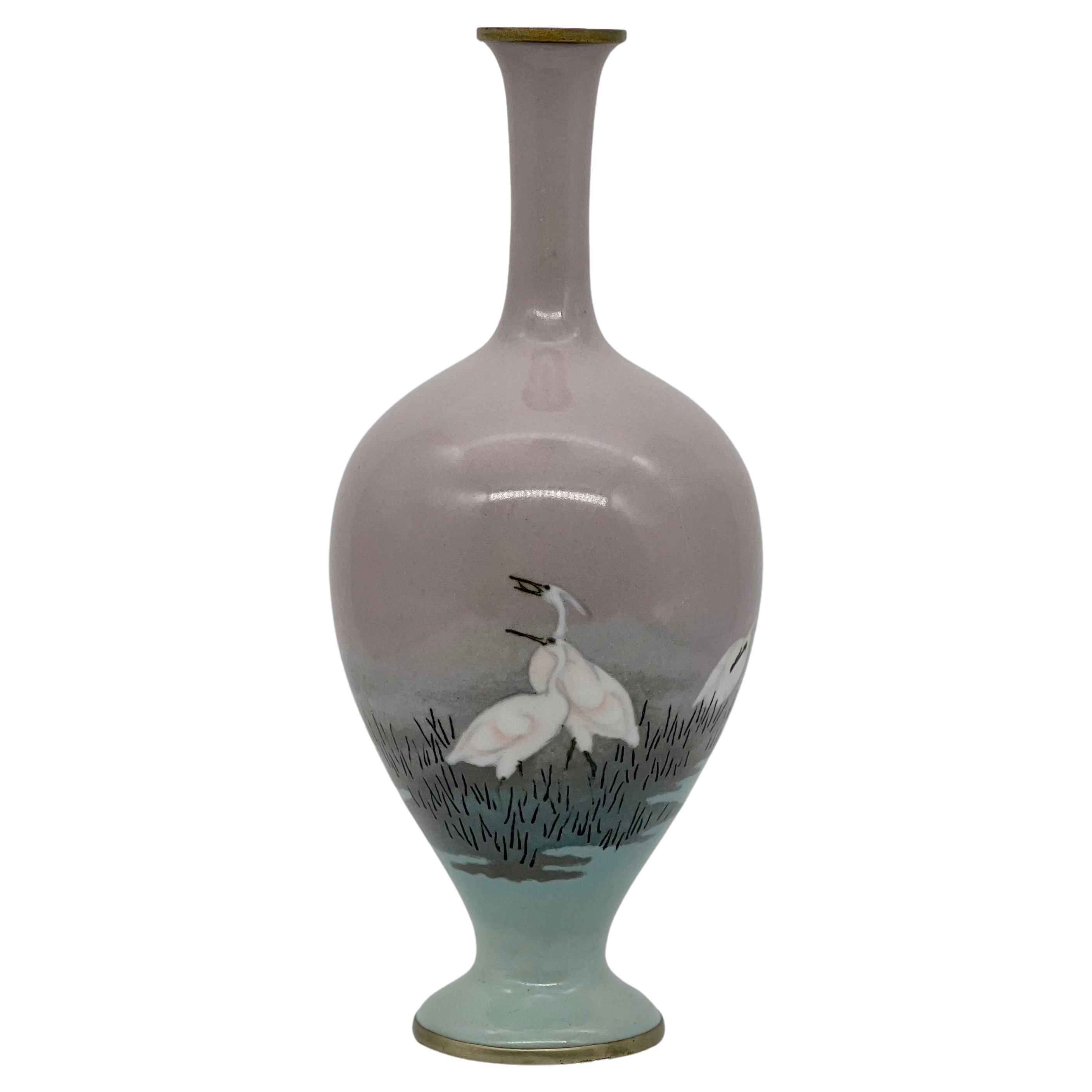Items Similar to Japanese Cloisonne Enamel Scent Bottle – Namikawa Yasuyuki
Video Loading
Want more images or videos?
Request additional images or videos from the seller
1 of 9
Japanese Cloisonne Enamel Scent Bottle – Namikawa Yasuyuki
About the Item
As part of our Japanese works of art collection we are delighted to offer this exceptional quality Meiji Period 1868-1912, circa 1895 cloisonne enamel scent bottle by the most highly regarded cloisonne master of the period, the Imperial artist Namikawa Yasuyuki 1845-1927. On this occasion Namikawa has manufactured a scent bottle of rounded form with opposing panels, the first panel depicts an exotic bird carrying a floral sprig in its mouth, the bird finely rendered in solid gold wire upon a buff coloured ground, the reverse depicts a gold wired butterfly in flight amidst a striking colourful garden scene upon a lighter yellow ground, the panels surrounded by more typical floral brocades to the circumference, the gilt domed lid screws nicely to the body and the underside is fully signed Namikawa Kyoto. An increasingly scarce piece of Japanese enamel from the golden age of cloisonne manufacture and carrying the signature of the undoubted master enameler.
Literature : Namikawa Yasuyuki (並川靖之) was among the most celebrated Japanese enamelers of the Meiji period , together with Namikawa Sosuke ( no relation) they became the most famous cloisonne artists of the 1890 to 1910 period, a time known as the “golden age” of Japanese enamels. Between 1875 and 1915 Yasuyuki won prizes at 51 exhibitions, including at world’s fairs and at national exhibitions. His pieces now form parts of many of the major recorded Japanese works of art collections and can be viewed in museums throughout the world.
Provenance :
USA Collection
Condition report :
Fine condition throughout
Approximate Sizes :
Height : 2 3/8 ” 6 cm
Width : 2″ 5 cm
Depth : 3/4″ 1.7 cm
Free worldwide delivery and a certificate of authenticity are included in the price of this item.
- Dimensions:Height: 2.375 in (6.04 cm)Width: 2 in (5.08 cm)Depth: 0.75 in (1.91 cm)
- Style:Meiji (Of the Period)
- Materials and Techniques:
- Place of Origin:
- Period:
- Date of Manufacture:Circa 1895
- Condition:Wear consistent with age and use.
- Seller Location:Christchurch, GB
- Reference Number:1stDibs: LU8622236601572
About the Seller
5.0
Vetted Seller
These experienced sellers undergo a comprehensive evaluation by our team of in-house experts.
Established in 2011
1stDibs seller since 2023
Typical response time: 1 hour
- ShippingRetrieving quote...Ships From: Christchurch, United Kingdom
- Return PolicyA return for this item may be initiated within 14 days of delivery.
More From This SellerView All
- Japanese Cloisonne Enamel Vase – Namikawa YasuyukiLocated in Christchurch, GBAs part of our Japanese works of art collection we are delighted to offer this striking Meiji Period 1868-1912, cloisonne enamel vase by the Imperial artist Namikawa Yasuyuki...Category
Antique 19th Century Japanese Meiji Metalwork
MaterialsSilver, Enamel
- Japanese Cloisonne Enamel Bottle Vase – Namikawa Yasuyuki (1845-1927)Located in Christchurch, GBAs part of our Japanese works of art collection we are delighted to offer this most exquisite Meiji Period 1868-1912, cloisonne enamel bottle vase manufactured by the most highly revered enamel artist of the late 19th century, the imperial artist Namikawa Yasuyuki...Category
Antique 19th Century Japanese Meiji Metalwork
MaterialsGold, Silver, Enamel
- Fine Japanese Cloisonne Enamel Vase – Namikawa YasuyukiLocated in Christchurch, GBAs part of our Japanese works of art collection we are delighted to offer this fine quality Meiji Period (1868-1912) cloisonne enamel vase manufactured by the Imperial artist Namikawa Yasuyuki...Category
Antique 19th Century Japanese Meiji Metalwork
MaterialsSilver, Enamel, Wire
- Large Japanese Gold Wire Cloisonne Enamel Box – Ando JubeiBy Ando JubeiLocated in Christchurch, GBAs part of our Japanese works of art collection we are delighted to offer this large fine quality Meiji Period (1868-1912) cloisonne enamel box from the highly regarded studios of Ando Jubei, the over sized lidded box is predominately worked in musen or wireless enamels brilliantly shaded in the manner of Namikawa Sosuke...Category
Antique 19th Century Japanese Meiji Metalwork
MaterialsMetal, Enamel
- Large Japanese Cloisonne Enamel Vase Ando CompanyBy Ando JubeiLocated in Christchurch, GBAs part of our Japanese works of art collection we are delighted to offer this stunning early 20thc Meiji/Taisho period , circa 1920’s Cloisonné ename...Category
20th Century Japanese Taisho Metalwork
MaterialsSilver, Enamel, Wire
- Large Japanese Cloisonne Enamel Vase – Mt Fuji – Ando CompanyBy Ando JubeiLocated in Christchurch, GBAs part of our Japanese works of art collection we are delighted to offer this large Taisho period 1912-1926 , circa 1920’s , Cloisonné vase by the An...Category
20th Century Japanese Taisho Metalwork
MaterialsSilver, Enamel, Wire
You May Also Like
- Exquisite Cloisonné Enamel Vase and Cover in the Manner of Namikawa YasuyukiLocated in London, GBA Exquisite Cloisonné enamel vase and cover in the Manner of Namikawa Yasuyuki . Meiji period. A 19th century Japanese cloisonne lidded vase and...Category
Antique Late 19th Century Metalwork
MaterialsEnamel
- Fine Japanese Cloisonné-enamel and Musen Vase Attributed to Namikawa SosukeLocated in London, GBA magnificent Cloisonné-enamel and Musen Baluster vase attributed to Namikawa Sosuke. Meiji era (1868-1912), late 19th century. This vase features an elegant classic form with a sle...Category
Antique Late 19th Century Japanese Metalwork
MaterialsEnamel
- Antique Japanese Meiji Cloisonné Enameled & Lidded Scent Dragon Jar C1920Located in Big Flats, NYAntique Japanese Meiji Cloisonné Enameled, Footed & Lidded Scent Jar with Dragon and Flowers C1920 Measures- 5''H x 5.25''W x 5.25''DCategory
Early 20th Century Japanese Meiji Metalwork
MaterialsMetal
- Japanese Wireless Cloisonné Serving Tray Meiji After Namikawa SosukeLocated in New York, NYA rare 19th Century Japanese copper serving tray with cloisonne enamel design. The central part of the tray depicts a wireless cloisonne picture, a coastal landscape view with a full moon. The hieroglyphical signature of the artist is in the lower right. The rims and the backside are decorated with floral ornaments. Blue and black color palette. Collectible Oriental Decor And Applied Arts For Interior Design. Namikawa Sosuke (1847–1910) was a Japanese cloisonné artist,[1] known for innovations that developed cloisonné enamel into an artistic medium sharing many features with paintings.[2][3] He and Namikawa Yasuyuki (no relation)[notes 1] were the most famous cloisonné artists of the 1890 to 1910 period, known as the "golden age" of Japanese enamels.[1] Around 1880 he set up and ran the Tokyo branch of the Nagoya Cloisonné Company.[1] He exhibited his artworks at national and international expositions, where he took an organising role.[2] He was recognised as an Imperial Household Artist and created art works for imperial residences. He sometimes signed his works with the character sakigake (Pioneer) the art work is based off a art work done by Sesshu Toyo Sesshu Toyo (?? ??, c. 1420 – August 26, 1506), also known simply as Sesshu (??), was a Japanese Zen monk and painter who is considered a great master of Japanese ink painting. Initially inspired by Chinese landscapes, Sesshu's work holds a distinctively Japanese style that reflects Zen Buddhist aesthetics.[1] His prominent work captured images of landscapes, portraits, and birds and flowers paintings, infused with Zen Buddhist beliefs, flattened perspective, and emphatic lines.[2] Sesshu was born into the samurai Oda family (???) and trained at Shokoku-ji temple in Kyoto, Japan, as a Zen monk.[1] From his early childhood, Sesshu showed a talent for painting and eventually became widely revered throughout Japan as a wise, reputable Zen scholar, and the greatest painter priest of Zen-Shu.[3] Sesshu worked in a painting atelier whilst training under Tensho Shubun (c. 1418–1463). But upon visiting China, his work betook a distinctive Chinese influence, merging Japanese and Chinese styles to develop his individualistic style of Zen paintings.[3] Sesshu's influence on painting was so wide that many schools of art appointed him their founder.[4] Sesshu's most acclaimed works are Winter Landscape (c. 1470s), Birds and Flowers (1420–1506) and Four Landscape Scrolls...Category
Antique Late 19th Century Japanese Metalwork
MaterialsCopper, Enamel
- Japanese Cloisonne Enamel Vase Ando CompanyBy Ando JubeiLocated in Newark, EnglandJapanese cloisonne enamel vase. The vase of globular form with tightly pinched neck and splayed opening decorated with a fine red ground enamel worked with wire and musen-shippo (wireless technique) with a central white rose with yellow tips surrounded by red leaves. The base signed to the centre with the Ando company mark and silver Jungin mark to the rim tashio-showa period. Notes Ando Cloisonné...Category
Mid-20th Century Japanese Meiji Metalwork
MaterialsSilver, Enamel
- Japanese Cloisonne Enamel Vase Ando CompanyBy Ando JubeiLocated in Newark, EnglandJapanese cloisonne enamel vase. The vase of ovoid form with circular opening, black enamel glaze and silver mounted rims. Boldly decorated with autumnal flowers and birds. To the top and bottom geometric patterns finish the vase. Notes Ando Cloisonné...Category
Early 20th Century Japanese Meiji Metalwork
MaterialsMetal, Silver, Enamel
Recently Viewed
View AllMore Ways To Browse
Foo Dog Incense Burners
Japanese Meiji Champleve And Bronze Urn
Lao Tian Li
Lao Zi
Lillian Florsheim
Louis Vuitton Las Vegas Locations
Maruki Japanese Bronze Boy
Meiji Bronze Camel
Mughal Wooden Tiger
Tibet Beer
Tibetan Prayer Bells
Tikka Box
Wood Beehive Bowl
20th Century Chinese Cloisonne Jin
Chola Dynasty
Japanese Edo Iron Tetsubin
Jeronimo Fuentes
Arabian Coffee Pots





